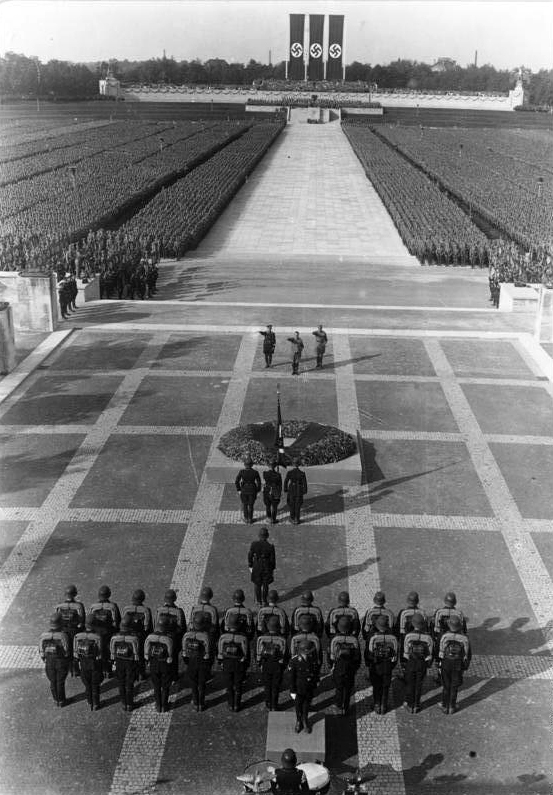|
Reichsparteitag
The Nuremberg Rallies (officially ', meaning ''Reich Party Congress'') refer to a series of celebratory events coordinated by the Nazi Party in Germany. The first rally held took place in 1923. This rally was not particularly large or impactful; however, as the party grew in size, the rallies became more elaborate and featured larger crowds. They played a seminal role in Nazi propaganda events, conveying a unified and strong Germany under Nazi control. The rallies became a national event once Adolf Hitler rose to power in 1933, when they became annual occurrences. Once the Nazi dictatorship was firmly established, the party's propagandists began filming them for a national and international audience. Nazi filmmaker Leni Riefenstahl produced some of her best known work including ''Triumph of the Will'' (1934) and ''The Victory of Faith'' (1933), both filmed at the Nazi party rally grounds near Nuremberg. The party's 1938 Nuremberg rally celebrated the Anschluss that occurred ear ... [...More Info...] [...Related Items...] OR: [Wikipedia] [Google] [Baidu] |
Nazi Party Rally Grounds
The Nazi party rally grounds (german: Reichsparteitagsgelände, literally: ''Reich Party Congress Grounds'') covered about 11 square kilometres in the southeast of Nuremberg, Germany. Six Nuremberg Rally, Nazi party rallies were held there between 1933 and 1938. Overview The grounds included: * the ''Luitpoldarena'', a deployment area * the Luitpold Hall or "Old Congress Hall" (damaged during World War II, later demolished) * the ''Kongresshalle'' (Congress Hall) or ''Neue Kongresshalle'' (New Congress Hall) (unfinished) * the ''Zeppelinfeld'' (Zeppelin Field), another deployment area * the ''Märzfeld'' (March Field) (unfinished, later demolished), a deployment area for the ''Wehrmacht'' (army) * the ''Deutsches Stadion, Deutsche Stadion'' (German stadium) (only foundations were built), which was to be the largest sports stadium in the world * the former ''Stadion der Hitlerjugend'' ("stadium of the Hitler Youth", today Frankenstadion) * the ''Große Straße'' ("Great Road"), ... [...More Info...] [...Related Items...] OR: [Wikipedia] [Google] [Baidu] |
Triumph Of The Will
''Triumph of the Will'' (german: Triumph des Willens) is a 1935 German Nazi propaganda film directed, produced, edited and co-written by Leni Riefenstahl. Adolf Hitler commissioned the film and served as an unofficial executive producer; his name appears in the opening titles. It chronicles the 1934 Nazi Party Congress in Nuremberg, which was attended by more than 700,000 Nazi supporters. The film contains excerpts of speeches given by Nazi leaders at the Congress, including Hitler, Rudolf Hess and Julius Streicher, interspersed with footage of massed Sturmabteilung (SA) and Schutzstaffel (SS) troops and public reaction. Its overriding theme is the return of Germany as a great power with Hitler as its leader. The film was produced after the Night of the Long Knives and many formerly prominent SA members are absent. Following its release in March 1935, it became a major example of film used as propaganda and was well-received at home. Riefenstahl's techniques—such as moving ... [...More Info...] [...Related Items...] OR: [Wikipedia] [Google] [Baidu] |
Nazi Party
The Nazi Party, officially the National Socialist German Workers' Party (german: Nationalsozialistische Deutsche Arbeiterpartei or NSDAP), was a far-right politics, far-right political party in Germany active between 1920 and 1945 that created and supported the ideology of Nazism. Its precursor, the German Workers' Party (; DAP), existed from 1919 to 1920. The Nazi Party emerged from the Extremism, extremist German nationalism, German nationalist, racism, racist and populism, populist paramilitary culture, which fought against the communism, communist uprisings in post–World War I Germany. The party was created to draw workers away from communism and into nationalism. Initially, Nazi political strategy focused on anti–big business, anti-bourgeoisie, bourgeois, and anti-capitalism, anti-capitalist rhetoric. This was later downplayed to gain the support of business leaders, and in the 1930s, the party's main focus shifted to Antisemitism, antisemitic and Criticism of ... [...More Info...] [...Related Items...] OR: [Wikipedia] [Google] [Baidu] |
Nazi Congress In Nuremberg, Germany (1936) - British Pathé
Nazism ( ; german: Nazismus), the common name in English for National Socialism (german: Nationalsozialismus, ), is the far-right totalitarian political ideology and practices associated with Adolf Hitler and the Nazi Party (NSDAP) in Nazi Germany. During Hitler's rise to power in 1930s Europe, it was frequently referred to as Hitlerism (german: Hitlerfaschismus). The later related term "neo-Nazism" is applied to other far-right groups with similar ideas which formed after the Second World War. Nazism is a form of fascism, with disdain for liberal democracy and the parliamentary system. It incorporates a dictatorship, fervent antisemitism, anti-communism, scientific racism, and the use of eugenics into its creed. Its extreme nationalism originated in pan-Germanism and the ethno-nationalist '' Völkisch'' movement which had been a prominent aspect of German nationalism since the late 19th century, and it was strongly influenced by the paramilitary groups that emerged after ... [...More Info...] [...Related Items...] OR: [Wikipedia] [Google] [Baidu] |
Albert Speer
Berthold Konrad Hermann Albert Speer (; ; 19 March 1905 – 1 September 1981) was a German architect who served as the Minister of Armaments and War Production in Nazi Germany during most of World War II. A close ally of Adolf Hitler, he was convicted at the Nuremberg trials and sentenced to 20 years in prison. An architect by training, Speer joined the Nazi Party in 1931. His architectural skills made him increasingly prominent within the Party, and he became a member of Hitler's inner circle. Hitler commissioned him to design and construct structures including the Reich Chancellery and the Nazi party rally grounds in Nuremberg. In 1937, Hitler appointed Speer as General Building Inspector for Berlin. In this capacity he was responsible for the Central Department for Resettlement that evicted Jewish tenants from their homes in Berlin. In February 1942, Speer was appointed as Reich Minister of Armaments and War Production. Using misleading statistics, he promoted himsel ... [...More Info...] [...Related Items...] OR: [Wikipedia] [Google] [Baidu] |



